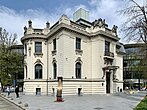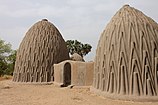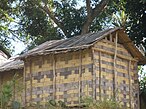
Back Rumoh ACE Huis Afrikaans Haus ALS መኖርያ ቤት Amharic Loma' AMI Casa AN Hūs ANG منزل Arabic ܒܝܬܐ (ܒܢܝܢܐ) ARC بيت ARZ
| Part of a series on |
| Living spaces |
|---|
 |
A house is a single-unit residential building. It may range in complexity from a rudimentary hut to a complex structure of wood, masonry, concrete or other material, outfitted with plumbing, electrical, and heating, ventilation, and air conditioning systems.[1][2] Houses use a range of different roofing systems to keep precipitation such as rain from getting into the dwelling space. Houses generally have doors or locks to secure the dwelling space and protect its inhabitants and contents from burglars or other trespassers. Most conventional modern houses in Western cultures will contain one or more bedrooms and bathrooms, a kitchen or cooking area, and a living room. A house may have a separate dining room, or the eating area may be integrated into the kitchen or another room. Some large houses in North America have a recreation room. In traditional agriculture-oriented societies, domestic animals such as chickens or larger livestock (like cattle) may share part of the house with humans.
The social unit that lives in a house is known as a household. Most commonly, a household is a family unit of some kind, although households may also have other social groups, such as roommates or, in a rooming house, unconnected individuals, that typically use a house as their home. Some houses only have a dwelling space for one family or similar-sized group; larger houses called townhouses or row houses may contain numerous family dwellings in the same structure. A house may be accompanied by outbuildings, such as a garage for vehicles or a shed for gardening equipment and tools. A house may have a backyard, a front yard or both, which serve as additional areas where inhabitants can relax, eat, or exercise.
- ^ Schoenauer, Norbert (2000). 6,000 Years of Housing (rev. ed.) (New York: W.W. Norton & Company).
- ^ "housing papers" (PDF). clerk.house.gov. Archived from the original (PDF) on January 17, 2013. Retrieved December 18, 2012.











